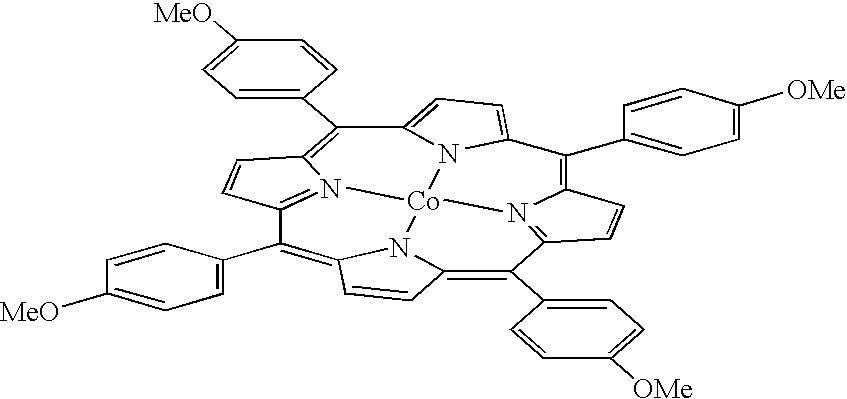Polymerization of diisopropenylbenzene
- Summary
- Abstract
- Description
- Claims
- Application Information
AI Technical Summary
Problems solved by technology
Method used
Image
Examples
example 1
Homopolymerization of 1,3-Diisopropenylbenzene with Azo Initiator
[0050] To a 250 mL 3-neck flask equipped with thermocouple, stir bar, and septum was added uninhibited 1,3-diisopropenyl benzene (190 mL, Aldrich, Milwaukee, Wis.), a cobalt chain transfer catalyst MeOEACoIII(DMG)2 (115 mg, Marshall Lab, Philadelphia, Pa.), Vazo(R) 64 (570 mg, DuPont, Wilmington, Del.), and 1,2-dichloroethane (40 mL, Aldrich, Milwaukee, Wis.). A condenser was connected to the flask and the solution was degassed with argon for 45 min. before heating to 100° C. under continuous, minimal nitrogen bubbling for 6 h. The cooled solution was diluted with hexane (200 mL, EMD Chemicals Inc., Gibbstown, N.J.) and filtered over silica gel to remove catalyst. Hexane was evaporated leaving a colorless liquid.
[0051] GPC of the reaction mixture gave relative intensities of dimer, trimer, tetramer and pentamer of 100 to 20 to 5 to 1 at a conversion of approximately 50%. Results are shown in Table 2.
example 2
Homopolymerization of 1,3-Diisopropenylbenzene with Hydrogen
[0052] To a 250 mL 3-neck flask equipped with thermocouple, stir bar, and septum was added uninhibited 1,3-diisopropenyl benzene (190 mL, Aldrich, Milwaukee, Wis.), a cobalt chain transfer catalyst MeOEACoIII(DMG)2 (115 mg, Marshall Lab, Philadelphia, Pa.), and 1,2-dichloroethane (40 mL, Aldrich, Milwaukee, Wis.). A condenser was connected to the flask and the solution was degassed with argon for 20 min. followed by hydrogen for 45 min. before heating to 100° C. under minimal hydrogen flow for about 18 h. The cooled solution was diluted with hexane (200 mL, EMD Chemicals Inc., Gibbstown, N.J.) and filtered over silica gel to remove catalyst. Hexane was evaporated leaving a colorless, viscous polymer.
[0053] The high oligomer nature of the homopolymer product is indicated by the GPC results in Table 2 where the higher species are quite evident. The same type of distribution is observed in the mass spectrum where it is also ...
example 3
Homopolymerization of 1,3-Diisopropenylbenzene to High Conversion
[0054] To a 250 mL 3-neck flask equipped with thermocouple, stir bar, and septum was added uninhibited 1,3-diisopropenyl benzene (190 mL, Aldrich, Milwaukee, Wis.), the cobalt chain transfer catalyst, MeOEACoIII(DMG)2 (115 mg, DuPont Co., Philadelphia, Pa.), and 1,2-dicholorethane (40 mL, Aldrich, Milwaukee, Wis.). A condenser was connected to the flask and the solution was degassed with argon for 20 min. followed by hydrogen for 45 min. before heating to 100° C. under continuous, minimal hydrogen bubbling for about 18 h resulting in a viscous, orange polymer.
[0055] The higher MW polymer was not entirely soluble in hexane so the catalyst removal step was not carried out. GPC indicates a molecular weight (Mw) of 2000 with appreciable mass out to 10,000. The monomer peak indicates that conversion was greater then 95%. The distribution of products by mass spectroscopy is indicated in Table 2.
PUM
| Property | Measurement | Unit |
|---|---|---|
| Temperature | aaaaa | aaaaa |
| Temperature | aaaaa | aaaaa |
| Temperature | aaaaa | aaaaa |
Abstract
Description
Claims
Application Information
 Login to View More
Login to View More - R&D Engineer
- R&D Manager
- IP Professional
- Industry Leading Data Capabilities
- Powerful AI technology
- Patent DNA Extraction
Browse by: Latest US Patents, China's latest patents, Technical Efficacy Thesaurus, Application Domain, Technology Topic, Popular Technical Reports.
© 2024 PatSnap. All rights reserved.Legal|Privacy policy|Modern Slavery Act Transparency Statement|Sitemap|About US| Contact US: help@patsnap.com










